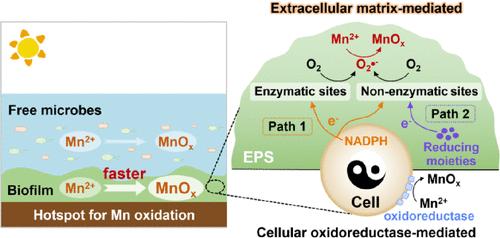微生物胞外基质介导的双途径电子转移使水生生物膜成为锰氧化的热点
IF 11.3
1区 环境科学与生态学
Q1 ENGINEERING, ENVIRONMENTAL
引用次数: 0
摘要
由于生成的氧化锰矿物的特殊氧化和吸附特性,锰(II)氧化控制了许多元素的地球化学循环。这一过程主要被认为是由微生物利用细胞氧化还原酶驱动的。在此,我们发现了微生物锰(II)氧化的新途径,该途径由生物膜细胞外基质介导,即微生物分泌的细胞外聚合物(EPS)。由于富含EPS,该生物膜成为光照水生系统中锰(II)氧化的热点,当细胞数归一化时,其氧化锰(II)的能力比自由微生物高2.9倍。氧化还原酶如NAD(P) h氧化酶和非酶氧化还原组分如黄素和醌在EPS介导电子从细胞内NADPH转移到氧产生超氧化物。此外,EPS内的醌类在光照射下介导电子从细胞外基质中的还原性部分(如硫醇和酚类)转移到氧中产生超氧化物。结果,EPS通过这两种电子传递途径产生的超氧化物促进了锰(II)的氧化。这种生物膜驱动的锰(II)快速氧化过程被发现在不同的阳光照射的水生环境中普遍存在。这项研究扩展了微生物驱动的锰以及自然界中其他元素循环的框架。本文章由计算机程序翻译,如有差异,请以英文原文为准。

Aquatic Biofilm as a Hotspot for Manganese Oxidation Enabled by Microbial Extracellular Matrix-Mediated Dual-Pathway Electron Transfer
Manganese(II) oxidation governs the geochemical cycles of numerous elements owing to the exceptional oxidation and adsorption properties of resultant manganese oxide minerals. This process is predominantly thought to be driven by microorganisms using cellular oxidoreductases. Herein, we uncovered a new pathway for microbial manganese(II) oxidation mediated by a biofilm extracellular matrix, i.e., extracellular polymeric substances (EPS) secreted by microorganisms. Owing to abundant EPS, the biofilm emerged as a hotspot for manganese(II) oxidation in a sunlit aquatic system, and its ability to oxidize manganese(II) was 2.9 times higher than that of free microorganisms when normalized by the cell number. Both oxidoreductases such as NAD(P)H-oxidizing enzymes and nonenzymatic redox components like flavins and quinones in the EPS mediated electron transfer from intracellular NADPH to oxygen to produce superoxide. Additionally, quinones within the EPS under light irradiation mediated electron transfer from reducing moieties (e.g., thiols and phenols) in the extracellular matrix to oxygen to generate superoxide. As a result, EPS boosted manganese(II) oxidation via superoxide generated by these two electron transfer pathways. This biofilm-driven rapid manganese(II) oxidation process was found to be prevalent across diverse sunlit aquatic environments. This study expands the framework of microbe-driven cycling of manganese as well as other elements in nature.
求助全文
通过发布文献求助,成功后即可免费获取论文全文。
去求助
来源期刊

环境科学与技术
环境科学-工程:环境
CiteScore
17.50
自引率
9.60%
发文量
12359
审稿时长
2.8 months
期刊介绍:
Environmental Science & Technology (ES&T) is a co-sponsored academic and technical magazine by the Hubei Provincial Environmental Protection Bureau and the Hubei Provincial Academy of Environmental Sciences.
Environmental Science & Technology (ES&T) holds the status of Chinese core journals, scientific papers source journals of China, Chinese Science Citation Database source journals, and Chinese Academic Journal Comprehensive Evaluation Database source journals. This publication focuses on the academic field of environmental protection, featuring articles related to environmental protection and technical advancements.
 求助内容:
求助内容: 应助结果提醒方式:
应助结果提醒方式:


